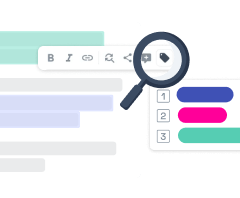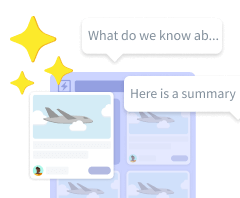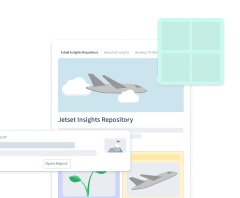
Driving Stakeholder Adoption & Engagement: A Comprehensive Guide
Once you decide to implement a research repository in your organization, you’ll soon face one of the biggest tasks: introducing it to your stakeholders. Convincing them to adopt a new single source of information, one that you’ve carefully prepared and invested time into, can be quite a challenge. After all, introducing a repository is not just about rolling out a new tool; it’s a change management initiative, and many of these initiatives tend to fail. But why?
Often, the resistance comes down to a combination of old habits, time constraints, and convenience. Chances are, your colleagues already work with multiple tools and might simply not be excited to learn yet another one. With everything else competing for their attention, putting another thing on their plate might feel like a big task. And even if the current system is far from ideal, getting your stakeholders to believe in the benefits of a new solution won’t happen overnight.
Achieving long-term adoption of your repository takes more than just an announcement - it requires strategy, effort, and planning. But don’t feel discouraged! At Condens, we’ve helped hundreds of customers navigate this very process, and we know that successful adoption is within reach. Below, we’ve compiled our best insights and created a step-by-step guide to help you introduce your stakeholders to the repository and keep them engaged over the long term.
- Phase 1: Laying the Groundwork Before Inviting Stakeholders
- Get to know your audience
- Choose the best stakeholder role for each team member
- Tailor your Research Magazine to stakeholder needs
- Designate Repository Support Contacts
- Phase 2: Introducing Your Repository to Stakeholders: Soft vs Grand Launch
- Making the most of your launch
- Choosing the Right Approach
- Summary: Soft vs Grand Launch
- Phase 3: Maintain stakeholder engagement
- Make your research easy to discover
- Schedule consistent stakeholder check-ins
- Encourage interaction and feedback
- Focus on quality and relevance
- Support habit formation

Need extra help with driving adoption in your organization? Reach out to our Customer Success Team for support!

Phase 1: Laying the Groundwork Before Inviting Stakeholders
Your goal: Build a strong foundation so your stakeholders have a smooth and engaging first experience with the repository. If your repository is organized and visually appealing from the start, stakeholders are more likely to return and explore it regularly.
One of the most common mistakes in rolling out a new repository is giving every stakeholder immediate access right after purchasing the tool.
You might announce it proudly at a company-wide meeting or send an official email containing a repository link. However, this often results in stakeholders simply clicking through and finding little to hold their interest. Convincing them to revisit later becomes an uphill battle.
Instead of rushing into a early launch, give yourself and your team time to set up the repository for your stakeholders. By following the steps below, you will make the experience more inviting and encourage long-term engagement:
Get to know your audience
Before building your repository, consider a few key questions:
Who are your stakeholders?
What are their roles?
Are they familiar with user experience research?
Do they prefer long, text-based reports or more visual forms of research findings?
What questions have they raised about research in the past?
What do they hope to find in the repository?
Answers to these questions will guide you in building a taxonomy and shaping insights that fit your stakeholders’ needs and expectations.
For example, if they usually prefer a traditional report format, you can create an Artifact Template in Condens and encourage your team to use it as the default for sharing insights. If they gravitate toward visuals, consider adding video clips, highlight reels, or even a whiteboard.
And if you don’t know the answers to all these questions yet, that’s your cue to learn more about your stakeholders first! A little bit of research can shed light on how stakeholders typically consume research and whether they’d rather have concise summaries or more detailed findings.
„It's important to understand how your stakeholders will search. Who will use the research repository? Is it sales, marketing, UX designers? What are their needs? And then also ask yourself: why will the user look for research? What are the things that they try to achieve? What needs to be the benefit for the user when using a research repository?“

Choose the best stakeholder role for each team member
This small step often gets overlooked but can shape how smoothly your repository runs. Condens lets you manage access permissions with two stakeholder roles:
1. Stakeholder
This role grants access only to the dedicated stakeholder repository - a curated list of insights you chose to publish - where the Condens Magazine serves as the homepage. The Magazine has a clean layout with a powerful AI search, making it easy for stakeholders to find relevant information.
This user role is ideal for those with alight to moderate interest in user research, such as executives, support teams, or department leads who need quick, digestible insights.
2. Full-Access Stakeholder
This role offers complete read access to everything in the repository, including raw data like user interviews, transcripts, tags, and the Participant list. While it provides more search options and deeper insight, it also calls for a stronger understanding of Condens.
Full access is typically best for team members who want greater involvement in research activities, like UX designers, product managers, or marketing teams.
Tailor your Research Magazine to stakeholder needs
Now that you understand who your stakeholders are and what they need, it’s time to apply that knowledge to create an impactful repository.
In Condens, the Research Magazine serves as a personalized homepage, where you and your team highlight key findings, add context, and arrange content - while stakeholders simply browse, explore insights, and leave comments.
Because the Magazine is the first thing stakeholders see when they enter the repository, it’s worth making it both intuitive and engaging. Below are a few tips to consider while creating your Magazine:
1. Personalize your Magazine
Before publishing your first insights, give your Magazine a look and feel that resonates with your audience. Use a header image at the top of the page, include your company’s name, and incorporate your brand colors so the repository fits naturally with the rest of your organization’s identity.
2. Provide guidance and onboarding materials
Although the Magazine is designed to be user-friendly from the start, your stakeholders might still need extra help navigating it.
Providing guidelines and manuals can boost their comfort and confidence with the repository. Tailor these materials to your audience’s questions and expectations - whether it’s short video tutorials on searching the repository or dedicated Artifacts that outline key navigation tips.
You might also create a resource specifically for new hires, introducing them to your user base and foundational research insights.
Consider adding a short FAQ or troubleshooting Artifact that addresses common questions and offers quick tips, so new users can find immediate answers without having to reach out.
If your organization uses other knowledge-sharing platforms, such as SharePoint, Confluence, or Google Drive, referencing them here can help stakeholders see how the repository fits into your broader resource ecosystem.
Place these materials at the top of your Magazine so they’re the first thing stakeholders see before they begin exploring. You can even add a welcome message, setting the tone and letting them know what to expect from your research repository.
3. Publish a meaningful amount of content
Building on our first point, launching the Magazine with just one or two insights likely won’t keep stakeholders engaged - and might even discourage them from returning. Instead, plan to publish and organize multiple Artifacts and Highlights that bring real value to your audience.
How much content is enough? That depends on factors like your organization’s size, the frequency of your research studies, and their depth.
As a starting guideline, try to include 8-10 Artifacts that represent different aspects of your research - say a usability test report, one or two Persona overviews, a collection of common user pain points, or a customer interview executive summary. Pair these with a few recent Highlights and Highlight Reels to give your audience a quick, engaging overview of your latest findings.
Ultimately, it’s not about quantity; it’s about the relevance of your research.

If you’re not familiar with editing your Condens Magazine yet, check out this article for a quick how-to.
Designate Repository Support Contacts
Once the Magazine is set up and stakeholder roles are assigned, you’re almost ready to introduce your new repository to a wider audience.
Before you do, take a small but important step: delegate and prepare a list of colleagues who will serve as your main points of contact for stakeholders.
Your “Condens champions” should be ready to:
Guide new users
Address questions about the repository
Offer support as needed.
You can include this list in an official repository email (more on that in Phase 2) or, even better, place it directly in the Magazine - perhaps next to a welcome page or as part of the manual mentioned earlier. Knowing there’s someone ready to help increases stakeholders’ confidence and encourages them to explore the repository.

Phase 2: Introducing Your Repository to Stakeholders: Soft vs Grand Launch
Your goal: Select the best approach to introduce your stakeholders to the new repository. Help them get used to the format and build a habit of using Condens as their go-to source for research insights.
Now that your repository is populated with key insights and ready for use, it’s time to decide how to introduce it to your stakeholders.
You might be tempted to organize a big official launch for the entire organization right away - and while that enthusiasm is natural, it’s not always the best strategy. Different organizations and teams have different needs, and the way you roll out your repository can largely impact its adoption and long-term success.
To guide this process, we’ve outlined two approaches that teams commonly take when introducing their repository:
A Soft Launch, where research is introduced gradually through familiar channels before inviting stakeholders into the repository itself.
A Grand Launch, where stakeholders are onboarded from day one, given full access, and trained to use the repository independently.
Each has its own advantages and challenges, and the right choice depends on your stakeholders, your organization’s UX research maturity, and your goals for the repository.
Making the most of your launch
The way you introduce your repository will influence how quickly stakeholders engage with it. Whether you take a gradual approach with a Soft Launch or go all-in with a Grand Launch, it’s important to set stakeholders up for success from the start.
1. Soft Launch
A Soft Launch takes a gradual approach, where the amount of content published in your repository is less important at the start since stakeholders won’t be exploring it right away. Instead, insights are shared directly with stakeholders through familiar channels, such as Slack, MS Teams, or email, before they are invited into the repository itself.
Rather than introducing the tool immediately, this method helps stakeholders get used to research findings in a way that feels natural, without requiring them to change their habits upfront. Once you notice growing interest and engagement, you can begin introducing training sessions and inviting selected stakeholders to start exploring the repository on their own.
2. Grand Launch
A Grand Launch requires more time, planning, and effort upfront, but it allows you to introduce the repository as a fully available resource from day one.
This approach is often paired with a formal announcement - such as an official email, a dedicated company newsletter, or an in-person meeting - where the repository is presented to the wider organization, along with clear expectations for how it will be used.
Training sessions are a key component of this method, helping stakeholders learn how to search, navigate, and engage with insights independently.
Since stakeholders will be expected to use the repository from the start, it’s important to have a good number of Artifacts and Highlights available before launch. In the first few weeks, staying available to answer questions and gathering feedback can help smooth the transition and encourage adoption.
Choosing the Right Approach
Now that you understand the two approaches, the next step is determining which one is the best fit for your organization.
The decision isn’t one-size-fits-all; it depends on several factors, such as:
Your stakeholders’ familiarity with research
How engaged they are
How much time you have to support them during onboarding.
Below are some key considerations to help guide your decision:
Understand your stakeholders’ needs
As with every step in this process, your stakeholders should be at the center of your decision-making. Consider their willingness and ability to engage with a new tool. Are they open to dedicating time to learn how to navigate the repository and find insights independently? Or do they prefer minimal disruption to their current workflow?
Analyze your stakeholder engagement
Take a close look at how your stakeholders have interacted with research in the past.
Have they shown consistent interest in your work?
Are they actively asking questions about the latest findings or seeking updates?
Have you heard complaints about the current repository or its accessibility?
These behaviors can be a signal that your stakeholders are eager for better access to research insights and may be ready for a Grand Launch. However, if engagement has been low, a Soft Launch may help build interest gradually by sharing smaller, targeted insights in a way that feels more approachable.
Assess your organization’s UX research maturity
The level of UX research maturity in your organization plays a key role in choosing the right launch strategy.
In highly mature organizations, stakeholders already understand the value of research and actively use it to inform their decisions. This makes them well-suited for a Grand Launch, where they can dive straight into the repository and quickly integrate it into their workflows.
For organizations with lower UX research maturity, it may take more time to establish trust and demonstrate the benefits of research. A Soft Launch allows researchers to introduce insights gradually, build credibility, and highlight the repository’s value step by step. This approach helps stakeholders feel more confident and invested over time.
Define your time constraints
The time you have to introduce the repository can also influence which launch strategy works best.
If there’s pressure to deliver results quickly, a Grand Launch might be the way to go. By focusing upfront on onboarding and training, stakeholders can start using the repository effectively sooner.
If your timeline allows for more flexibility, a Soft Launch could be a better fit. A more gradual introduction lets stakeholders explore the repository at their own pace, helping to build interest and motivation over time.
Evaluate your research content
The decision between a Soft or Grand Launch can also depend on how much content you have ready to populate your repository.
For newer research teams just starting to conduct and share insights, a limited amount of content might make a Soft Launch the better option. This gives you time to build a more comprehensive library before inviting stakeholders to explore the repository.
If your organization already has a well-established research practice and a significant number of insights have been shared across teams, a Grand Launch could be a better fit. Review the research you’ve produced so far and consider how often it’s been accessed or referenced.
These factors can help guide your decision and determine whether your repository is ready for a larger audience.
Consider stakeholder diversity
In many organizations, stakeholders vary in their level of engagement and motivation to explore research. Some may be eager to dive deeper and actively seek greater access, while others might prefer to engage more casually or need more time to see the value.
If this applies to your organization, a hybrid approach could be the ideal solution. Use a Soft Launch to engage less motivated stakeholders gradually, while organizing a Grand Launch for those who are ready to gain full access to the repository.
Summary: Soft vs Grand Launch
Here’s a quick side-by-side comparison to help summarize the main differences:


Phase 3: Maintain stakeholder engagement
Your goal: Build a long-lasting relationship between stakeholders and your research.
The success of your repository doesn’t stop at its launch. Even with all the effort you’ve put into the first two phases, the repository may still fail if stakeholders lose interest over time.
A single announcement about the repository isn’t enough - keeping your audience engaged requires consistent effort to make your research visible, accessible, and relevant. To help you achieve this, we’ve collected some of the most effective tips from our customers on how to keep stakeholders interested and foster a lasting connection with your research.
Make your research easy to discover
Use Condens integrations with MS Teams and Slack to keep stakeholders updated on your latest findings. Consider creating a dedicated channel in these platforms to centralize research updates and provide stakeholders with a space to access information and ask questions.
When sharing updates, try posting a short video snippet as a preview of the Artifact or a quick recap of recent research sessions to highlight key insights. These small, targeted updates not only spark curiosity but also encourage stakeholders to engage with the research and explore further.
Schedule consistent stakeholder check-ins
Many of our customers find value in organizing regular meetings with their stakeholders to showcase recent research activities and share deeper insights. These meetings (called by our customers Show & Tell or Meet & Greet) provide a great opportunity for stakeholders to ask questions, engage with the research, and build a stronger connection to its outcomes.
If regular meetings with your stakeholders are not an option, consider sharing quarterly or biannual newsletters instead. This helps keep stakeholders informed and gives them access to the most important updates
Encourage interaction and feedback
Whether your stakeholders receive single links to research findings or have full access to the whole repository, Condens allows them to leave comments and tag relevant people. Make sure your audience is aware of this feature - it’s a great way to keep them engaged and to help them communicate with the authors of the insights.

Focus on quality and relevance
Providing high-quality, relevant research is key to keeping stakeholders engaged and building their confidence in your repository. Rather than overwhelming them with too much data, focus on delivering insights that are directly useful to their work. Consistently sharing valuable and actionable information will help foster trust and encourage stakeholders to actively use and appreciate your repository.
Support habit formation
If your organization is transitioning from another repository tool or using multiple tools, include links to Condens Artifacts and findings in the tools your team already relies on. This helps gradually build the habit of treating Condens as the go-to place for research insights and makes the transition feel smoother and less stressful for everyone.
Launching a research repository is more than just creating a space for insights - it’s about building a bridge between your stakeholders and your research. Every step, from laying a solid foundation to choosing the right launch strategy and keeping your audience engaged, plays a vital role in its success.
The tips in this guide will help you create a resource your stakeholders actively rely on. By fostering trust, engagement, and habits around the repository, you’re setting the stage for research to make a lasting impact across your organization.




